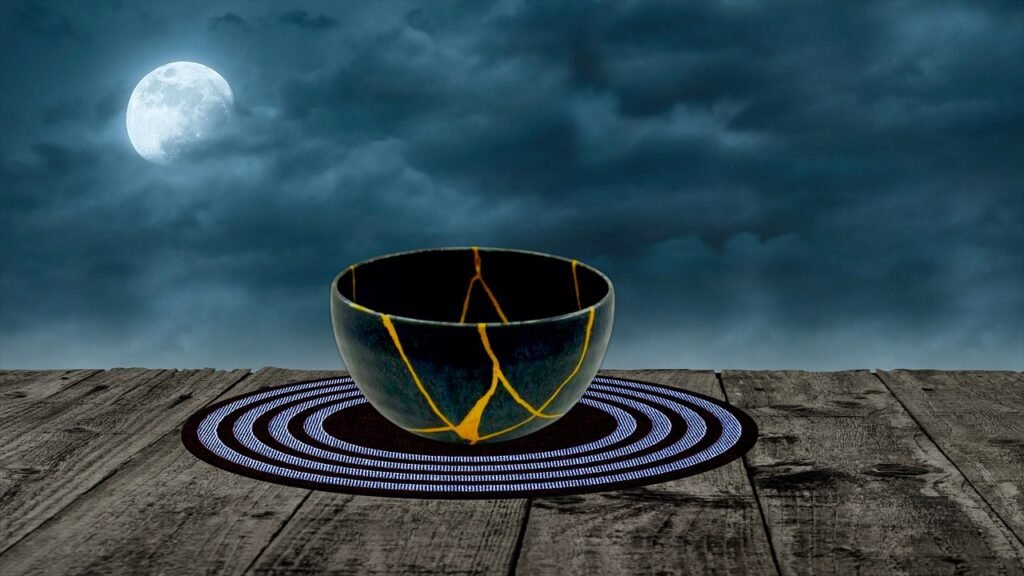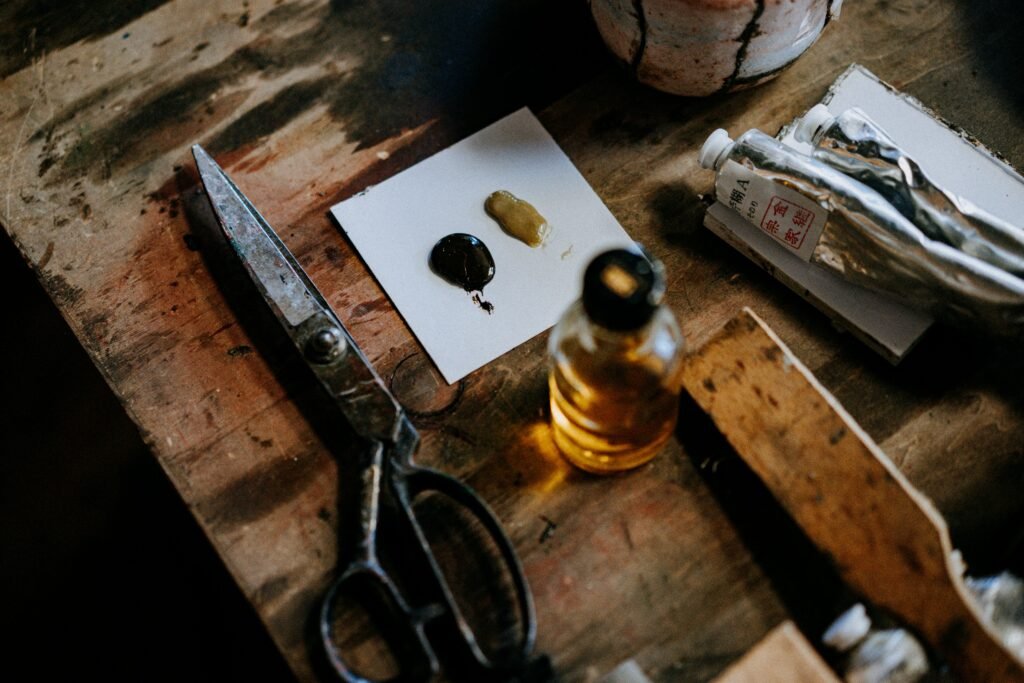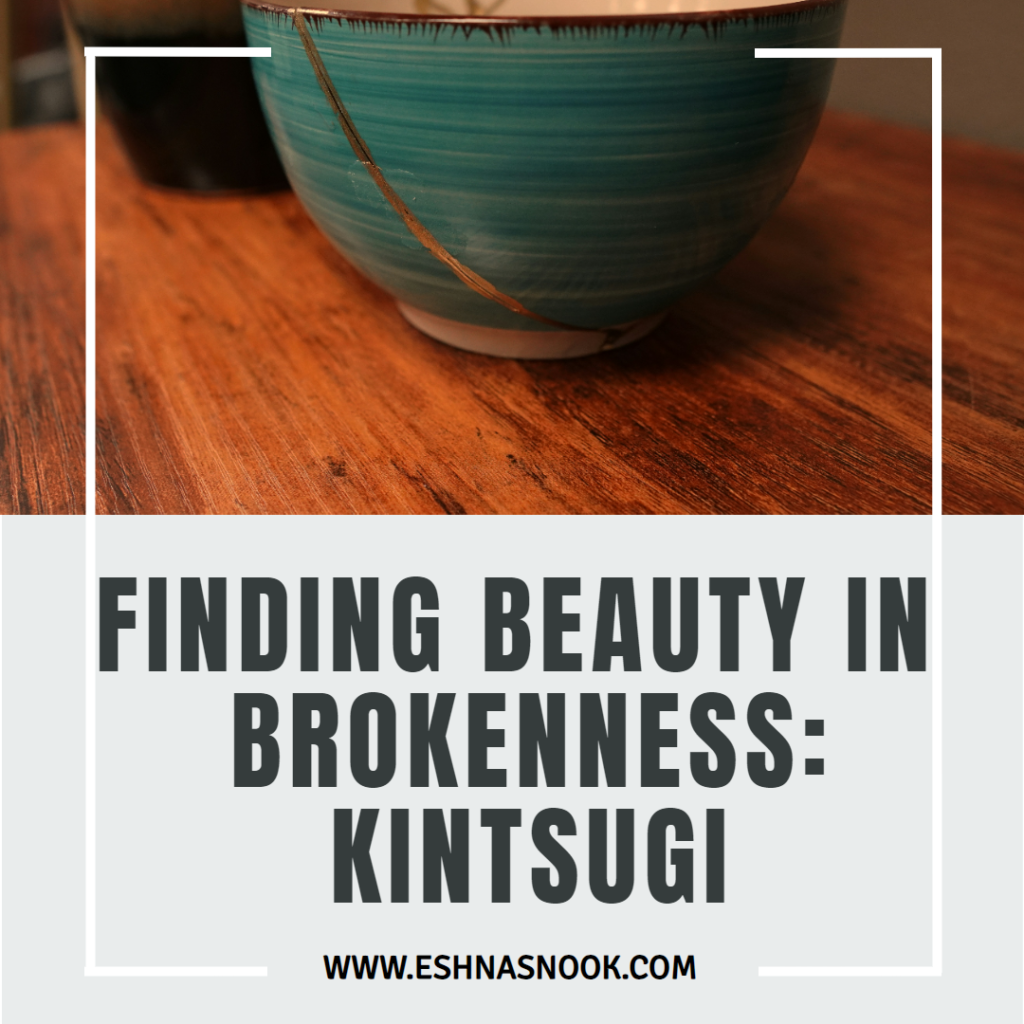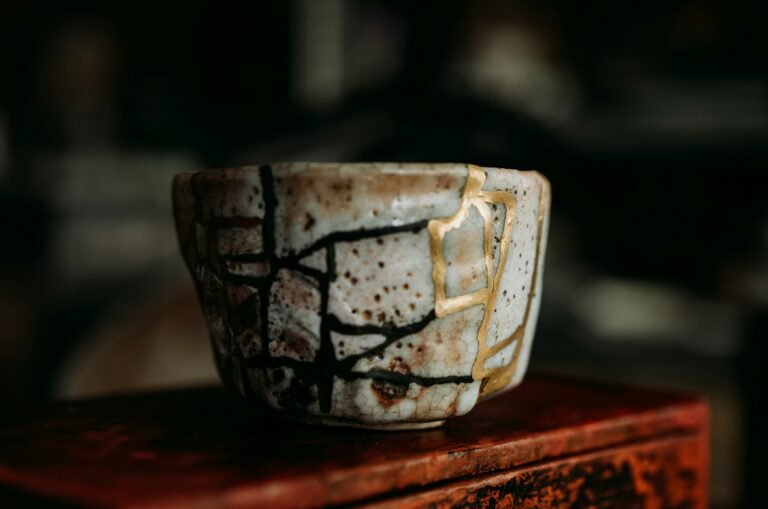Beauty in the Brokenness
This is a truth beautifully brought out by the centuries-old Japanese tradition of Kintsugi, which not only celebrates but embraces the flaws and imperfections of the broken.
As the story goes, in ancient Japan, there was a leader named Ashikaga Shogun Yoshimitsu.
He loved a special tea bowl that held many memories.
One day, it broke, and Yoshimitsu was sad. Instead of throwing it away, he asked his artisans to fix it.
They used special lacquer mixed with gold, making the cracks shine beautifully.
The repaired bowl looked even more amazing than before. The result was breathtaking.
The once-hidden breaks became gleaming veins of gold, highlighting the bowl’s history rather than hiding it.
The repaired bowl wasn’t just functional again, it was even more beautiful!
News of Yoshimitsu’s golden repair spread throughout Japan.
People began to see the beauty in mending, in embracing the flaws and stories etched into objects.
This philosophy, later called Kintsugi, meaning “golden joinery,” became a cherished tradition, reminding everyone that even broken things can be made whole again, often becoming even more beautiful in the process.
Kintsugi, also known as “the art of golden repair,” celebrates the beauty of imperfection
In running after perfection, we often overlook the beauty that lies in imperfection.
Kintsugi celebrates flaws and imperfections as unique traits that make objects more beautiful and tell story of its survival.
Kintsugi struck a chord in Japanese culture, where the idea of “wabi-sabi” prevails.
This philosophy embraces imperfection and acknowledges the transient nature of life.
It teaches that accepting flaws and recognizing the passage of time is where true beauty lies.

The Lessons of Kintsugi
Kintsugi teaches us important lessons that go beyond fixing broken pottery.
1.The Beauty of Imperfection:
In a world where perfection is valued, Kintsugi teaches us that imperfections are special and make our lives more interesting.
It shows that imperfections aren’t weaknesses but unique qualities that give depth to our lives.
We all have flaws and make mistakes, but rather than seeing them as weaknesses, we can view them as opportunities for growth.
Just as the broken pottery becomes more beautiful with gold seams, our experiences and challenges can add depth and beauty to our lives.
2.Acceptance and Resilience:
Life is full of cracks and breaks – setbacks, disappointments, and losses.
Kintsugi encourages us to accept these experiences as a part of our journey and to find the strength to repair ourselves, emerging stronger and more resilient.
It’s about learning from our failures and using them as stepping stones toward success.
3.Honoring your Scars:
The visible gold repairs in Kintsugi represent the scars we carry from life’s challenges.
These scars are not something to hide, they demonstrate our strength and perseverance.
Kintsugi teaches us that our struggles and challenges are not meaningless but integral parts of our journey.
By embracing our scars and imperfections, we can find meaning and purpose in life’s challenges and difficulties.
4.Transforming Pain into Strength:
Just as broken pottery is transformed into something even more beautiful through Kintsugi, so too can we emerge stronger and wiser from life’s hardships.
By embracing our weaknesses, we find the strength to overcome tough times.
5.The Power of Vulnerability:
Kintsugi celebrates the visible repairs, a metaphor for accepting vulnerability.
By acknowledging our weaknesses and struggles, we open ourselves up to connection and support from others.
Acceptance allows us to let go of guilt and shame, freeing us to move forward with clarity and purpose.
6.Learning from Setbacks:
Kintsugi teaches us that setbacks and failures are not the end of the road but opportunities for growth and learning.
By embracing our mistakes and challenges, we can develop resilience and strength.
7.Embracing Flaws in Others
In relationships, Kintsugi reminds us to embrace the flaws and imperfections in others.
By accepting each other’s vulnerabilities, we can cultivate deeper connections and foster empathy and understanding.
8.Repairing Broken Bonds
Just as Kintsugi repairs broken pottery, so too can it mend fractured relationships.
By acknowledging the cracks and imperfections in our connections, we can work toward reconciliation and healing.
9.Reframe Your Perception of Failure:
View setbacks not as dead ends, but as opportunities for growth and learning.
Look for the lessons in every experience, even the negative ones.
10.Own Your Imperfections:
Stop comparing yourself to others and accept your unique flaws and quirks.
What you perceive as imperfections might be what makes you special.
11.Celebrate Your Scars:
The experiences that have challenged you have shaped who you are today.
Wear your scars with pride – they tell a story of resilience and strength.
12.Practice Self-Compassion:
Be kind to yourself when you make mistakes.
Everyone makes mistakes; it’s a part of being human.
Forgive yourself and learn from the experience.
13.Find the Beauty in Imperfection:
Look for the beauty in the cracks and imperfections of the world around you.
A chipped cup, a weathered tree, a faded photograph – all tell a story and hold a unique beauty.

The Golden Repair: A Journey of Self-Discovery
Kintsugi offers a powerful metaphor for the human experience, reminding us that our scars and imperfections are not signs of weakness but symbols of resilience and growth.
Kintsugi is more than just an art form; it’s a way of life.
It encourages us to embrace the inevitable cracks and breaks in life, to find the beauty in imperfection, and to emerge from challenges stronger and more resilient.
The golden repair becomes a symbol of our resilience, a testament to our ability to heal and grow.
By embracing the spirit of Kintsugi, we embark on a journey of self-discovery, learning to appreciate ourselves and the world around us in all our flawed and magnificent glory.
So, when you come across something broken, don’t throw it away. Look for the beauty in the cracks and imperfections of the world around you.
A broken cup, an old tree, a faded photograph – all tell a story and hold a unique beauty.
Think about Kintsugi – it’s a chance to fix, to change, and to see the beauty in imperfection.
Remember, the most beautiful things often have stories of strength.
You will also like my post on How to stop Negative Self talk
FAQs (Frequently Asked Questions)
– Q: What is Kintsugi?
-A: Kintsugi is an ancient Japanese art form that involves repairing broken pottery with lacquer and gold or silver powder, celebrating imperfection and resilience.
– Q: What materials are used in Kintsugi?
– A:Traditional Kintsugi utilizes urushi (Japanese lacquer), gold or silver powder, and special brushes to repair broken ceramics.
– Q: What is the significance of Kintsugi?
– A: Kintsugi symbolizes the beauty of imperfection and resilience, transforming brokenness into a source of strength and beauty.
– Q:How does Kintsugi philosophy apply to life?
– A: The principles of Kintsugi encourage us to embrace our flaws and setbacks as opportunities for growth and transformation, fostering resilience and self-acceptance.
– Q: Can anyone practice Kintsugi?
– A: While Kintsugi requires skill and precision, anyone can embrace its philosophy of imperfection and resilience in their daily lives, fostering a deeper sense of acceptance and gratitude.
READ: HABITS TO GIVE UP ASAP


